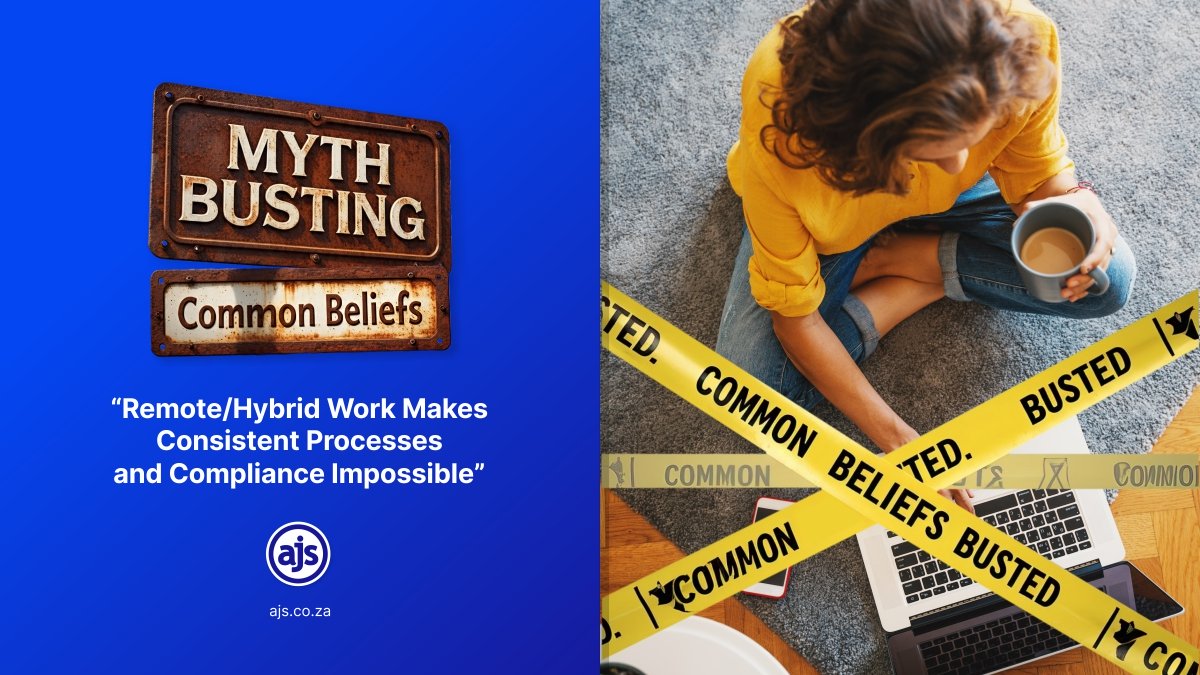
MYTH BUSTING COMMON BELIEFS: Part 8
Like “Remote/Hybrid Work Makes Consistent Processes and Compliance Impossible.”
We have come a long way since COVID.
Thankfully.
But the one thing that has followed us out of the whole COVID storm has been the whole work-from-home situation. Remote or hybrid working models have become the norm and according to Deloitte’s first Global Remote Work Survey for tax, almost 80% of more than 820 tax, HR, finance, mobility, and payroll professionals across the globe, have said they allow some level of remote and hybrid work.
That’s a lot of professionals fashioning their dining room tables into office desks.
But in an effort to attract and retain top talent, companies and businesses across the globe have had to embrace the remote working model or at least offer a hybrid model (just over half of respondents (53%) according to Deloitte), where professionals are able to work a set number of days at their assigned workplace and a set number of days where they can work remotely.
For a lot of people that has done away with the awful daily slog and long (sometimes expensive) commute into the office, the daily stress of needing to find someone to look after the kids, the extra stress of having to get home after work and still cook dinner and do the laundry. You know attend to daily life. Remote/hybrid work models have allowed some flexibility in work roles which has resulted in happier employees. Generally.
Micromanaging and having managers hovering over your workstation thereby creating additional stress leading to often toxic work environments has also lessened. All-in-all one could say that the remote/hybrid work situation has had a lot of positives. And while many companies – at least in the very beginning – thought it would result in employees slacking off, it turns out that the opposite is in fact more accurate. Employees often work too much, too long and need to learn proper time management in order to avoid burning out. Which is obviously not ideal.
But the point is this – remote/hybrid working models are here to stay. For the long run. And however, you see them (whether for or against), they have many advantages – reduced overhead for companies, smaller office space which leads to lower rent, less commuters which leads to less traffic congestion and less pollution – noise and fumes.
We could go on and on about the positives and negatives of the remote/hybrid work model but that’s not really the point of the article.
The point of this article is the argument that remote/hybrid working models make consistent processes and compliance impossible.
Shall we dive in?
Alleviate compliance and process problems with smart tools and automation
The key to solving these challenges lies in automation. A smart employee time tracking app with workforce analytics provides real-time insights, streamlines audits, and eliminates manual inefficiencies.
By replacing outdated processes with smarter solutions, you can reduce risks, save time, and ensure compliance while maintaining employee trust and autonomy.
Here’s how:
With a remote team, headaches often creep up with employees working across the globe. Each country has its own tax, and labour laws, including minimum wage requirements, overtime rules, and mandatory benefits like paid sick leave.
What to do:
- Track employee locations automatically – stop guessing where your team is working. Use a work time tracking app like Clockify, Toggl Track, and Harvest, offering features like automated tracking, project management, and invoicing. TimeCamp and Paymo are also noted for their capabilities, including GPS tracking and invoicing to automate location tracking, so you always know where employees are in real time. This data ensures you’re applying the right labour laws for each country, cutting out the guesswork and saving hours of manual effort.
- Stay ahead of changing labour laws – tax and labour laws are constantly shifting, and it’s impossible to keep up without help. In South Africa you have access to The South African Labour Law Reports Mobile App , which was developed to enable professionals as well as the public to have remote access via their Android mobile devices to South African Labour Law Reports judgments, CCMA rulings and awards, Bargaining Council rulings and awards, Current publications, i.e. CCMA Rules including rules of the various courts, 4th edition, South African Labour Law Reports’ seminar. These tools ensure you’re always applying the most current regulations.
- Register where it’s required – use location data to flag where registration is needed, and partner with local legal advisors to handle filings. Getting this right up front prevents expensive penalties down the road.
Ensure compliance with remote work hours with time tracking
Tracking work hours for remote employees can be very tricky. In certain countries and under certain situations in South Africa, you are required to document hours worked, overtime, and breaks for employees.
But when employees work from home, it’s easy for things to fall through the cracks—missed time logs, blurred boundaries between work and personal time, or skipped breaks.
What to do:
- Automate work hour tracking with smart tools – stop relying on employees to track their hours manually. Many work time tracking apps automatically log work hours, overtime, and even idle time, giving you a real-time view of your team’s activity.
- Monitor break periods for compliance – many remote time tracking tools can flag gaps in time logs to show whether employees take breaks. This protects both the company and the employees.
- Integrate Time Data with Payroll Systems – automation doesn’t stop at tracking. Sync your time-tracking tool with payroll platforms to ensure overtime is paid correctly and deductions align with labour laws. This integration eliminates payroll errors, keeps your team happy, and keeps you compliant.
Improve oversight of remote teams without micromanaging
As will be an obvious statement, remote work has made it harder to maintain visibility into employee’s schedules, availability, and adherence to work policies.
This lack of oversight can create challenges like inconsistent leave approvals, unverified time-off requests, and disengaged employees. Worse, attempts to regain control through micromanagement only erodes trust (sometimes further) and creates unnecessary tension.
What to do:
- Use workforce analytics to gain real-time visibility – workforce analytics tools range from business intelligence platforms like Tableau and Power BI to integrated HR systems such as Workday and ADP Workforce Now, and specialised people analytics platforms like Visier and UKG. Other options include programming languages like R and Python for custom analysis, and tools like Excel for basic data tasks. These tools provide real-time data on employee activity, including work hours, idle time, and time-off patterns. This allows you to easily spot trends like absenteeism or potential leave misuse without resorting to invasive monitoring.
- Standardise leave and attendance policies across teams – inconsistent policy enforcement often leads to frustration and disengagement. Use centralised HR tools like BambooHR or Gusto to implement clear, standardised leave and attendance policies that apply equally to all employees. These platforms allow you to automate policy management, track approvals, and provide managers with consistent guidelines.
- Empower managers with targeted insights – give managers the tools they need to address specific issues without micromanaging. Workforce analytics can highlight patterns, such as repeated late starts or excessive idle time, enabling managers to handle these situations directly and efficiently. Managers can maintain oversight without overstepping boundaries or damaging morale by focusing on actionable insights.
Streamline compliance audits for remote teams with centralised data
Compliance audits for remote teams are far more complex than for in-office staff. It’s a process of gathering and analysing data across multiple locations, ensuring alignment with labour laws, time-tracking requirements, and country-specific employment regulations.
What to do:
- Centralise workforce data for accurate audits – managing compliance data for remote teams across jurisdictions is a logistical challenge. Employee monitoring platforms like ActivTrak, Hubstaff, Teramind, Controlio, and Clockify, that offer features like real-time monitoring, activity dashboards, time tracking, and security alerts, (available as both cloud-based and on-premises solutions) consolidate employee location, work hours, and activity records into a single dashboard, making compliance data easily accessible.
- Generate clear, detailed compliance reports – preparing for an audit requires organised, accurate data. Monitoring platforms offer reporting features that allow managers to create customised reports that consolidate employee activity and time logs into a clear, centralised format. These reports provide a comprehensive view of workforce data, making it easier for managers or even HR to compile the necessary information for audits and ensure records are well-organised and easily accessible.
- Flag and address compliance gaps before they escalate – workforce analytics tools provide detailed insights into employee activity and time tracking, helping to identify irregularities such as underreported hours or inconsistent work patterns. By addressing these data gaps proactively, managers can ensure smoother audits, reduce compliance risks, and protect the organisation from potential penalties.
Some other points to consider
- Data security and asset protection – ensuring corporate assets and sensitive data are protected when employees work from diverse locations requires updated policies and robust security measures. To aid in this, proactively revise policies for data security, asset protection, and compliance to reflect the realities of a remote or hybrid workforce. You could also implement and utilise technology to streamline workflows, facilitate communication, manage data, and provide secure access to company resources for all employees.
- Communication and culture – maintaining effective communication and a unified corporate culture can be difficult with a dispersed workforce, potentially impacting collaboration and compliance reporting. In order to alleviate this, you should establish clear communication channels and provide consistent messaging regarding policies, expectations, and obligations for all employees. In addition, design workflows and provide resources that ensure fairness and equal opportunity for all employees, regardless of their work location.
- Training and onboarding – as you might have guessed, delivering consistent and effective training and onboarding to both remote and in-office employees can present a significant challenge. Especially where common experience is concerned. But this is where a company can really show off how they “roll with the punches” so to speak. Companies will now need to develop training programs that address the unique challenges of remote and hybrid work, ensuring all employees understand their obligations and company standards – regardless of where they’re situated.
Remote/hybrid work models don’t inherently make consistent processes and compliance impossible – because let’s be honest nothing is really impossible. Instead, hybrid/remote work models introduce new challenges, they add a little “flavour” to what is a normal workday such as ensuring data security, adhering to varied labour laws, maintaining consistent training, and preventing inequality between remote and in-office staff.
Companies can overcome these hurdles by updating policies, leveraging technology, establishing clear communication channels, and providing consistent training and resources for all employees equally across the board.
We think that the answer to this conundrum is plain for all to see – the myth about client remote/hybrid work models making processes and compliance impossible is BUSTED! By implementing the right tools, automating the right processes, and ensuring that policies and procedures are applied evenly across the business – whether remote or in-office ensures that nothing is impossible. Slightly more colourful? Maybe. Impossible? Never.
(We recommend reading this article for more practical points on IT infrastructure).
If you are in need of a service provider who has a proven track record or if you want to find out how to incorporate a new tool into your existing practice management suite – or if you simply want to get started with legal tech – feel free to get in touch with AJS. We have the right combination of systems, resources, and business partnerships to assist you with incorporating supportive legal technology into your practice. Effortlessly.
AJS is always here to help you, wherever and whenever possible!
– Written by Alicia Koch on behalf of AJS
(Sources used and to whom we owe thanks – Time Champ; Insightful; Zapier and Deloitte)





Leave a Reply